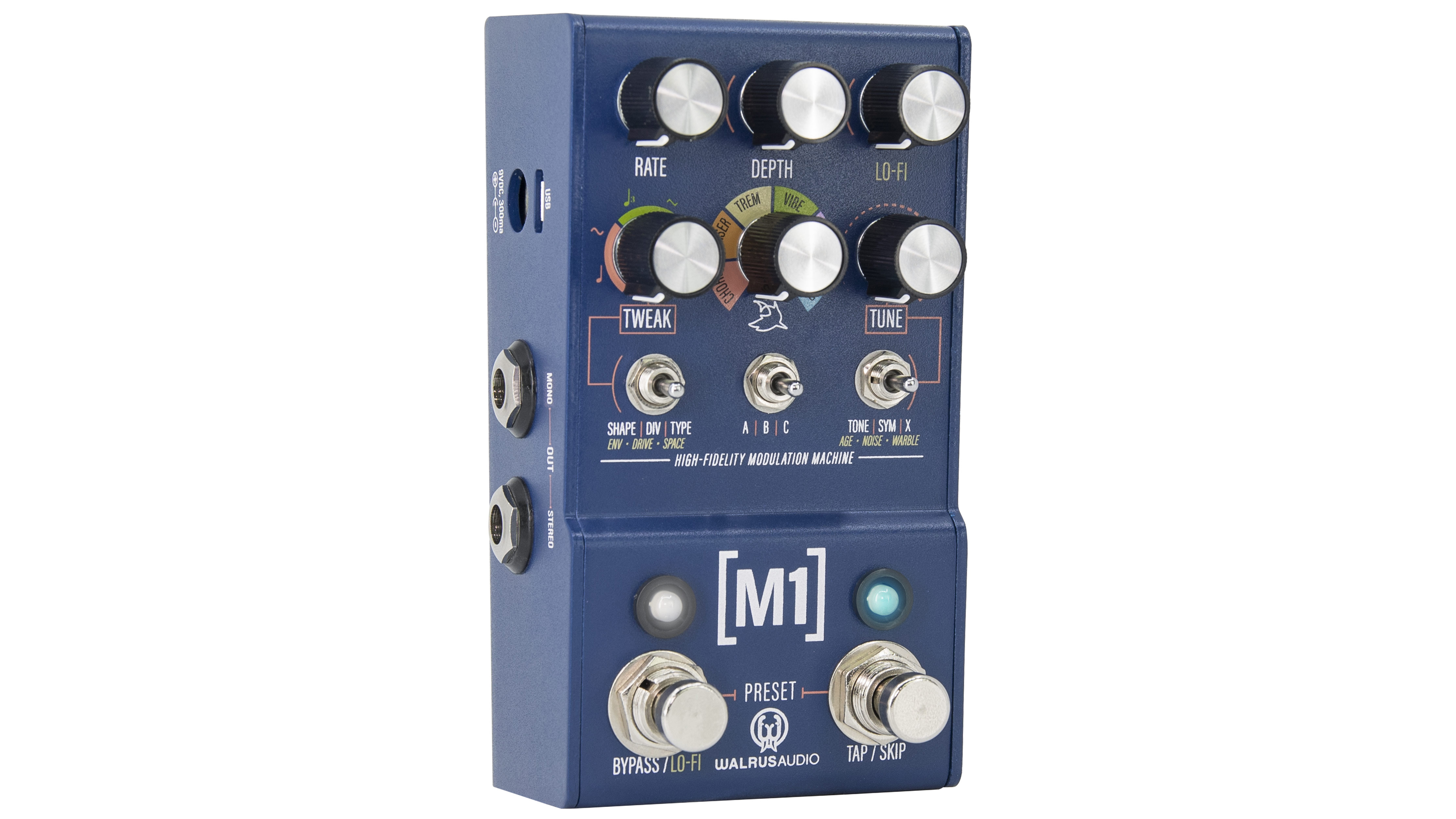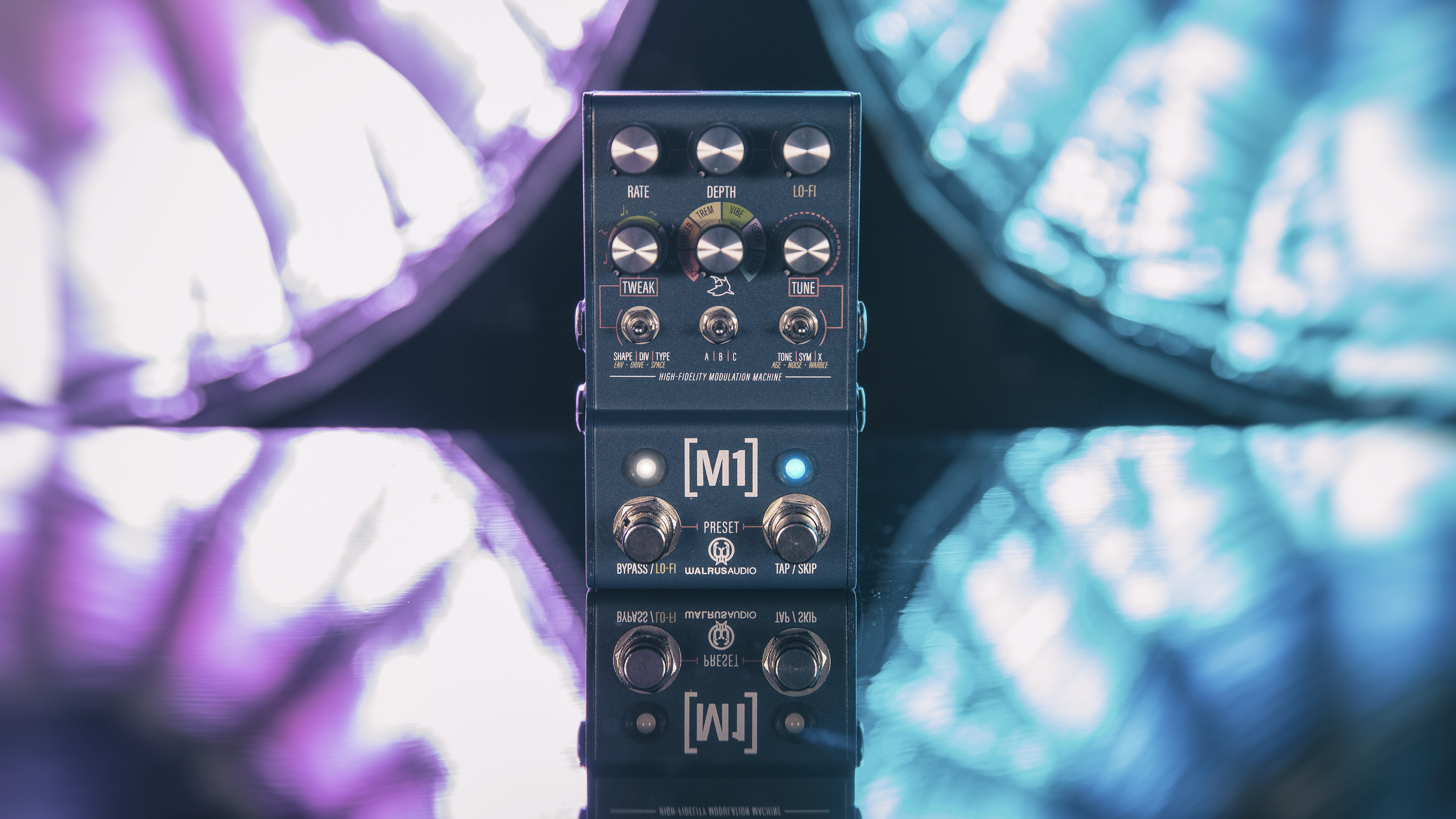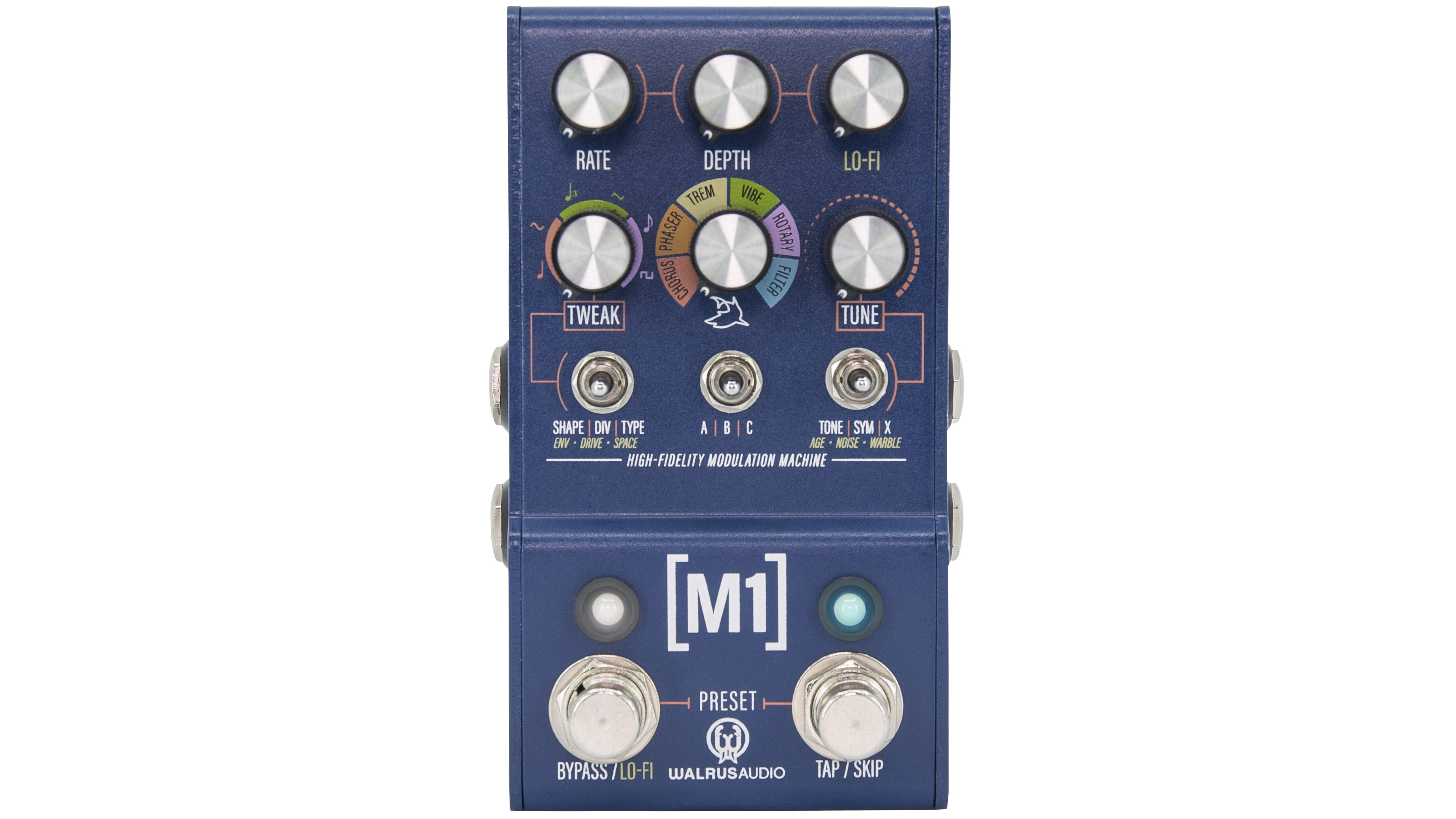MusicRadar Verdict
MusicRadar verdict: You can go as deep as you want here with the huge array of sounds in a compact unit. The M1 is an especially rewarding pedal for fans of lo-fi and ambient modulation, or indeed anyone who likes to invest time in creating fresh, otherworldly tones.
Pros
- +
Great selection of effects with three types of each.
- +
Huge scope for manipulation with an array of parameters.
- +
9 presets makes this great compact option for the stage.
Cons
- -
Filter instead of a flanger is an odd choice to us.
MusicRadar's got your back
What is it?
Walrus Audio unveiled the very first pedal in its Mako Series with the D1 High-Fidelity Stereo Delay back in the beginning of 2020. It was a departure of sorts; or more, an expansion. The idea of a premium one-stop pedal for delay had been done before but this was a new level in glorious compact versatility. And Walrus followed it up.
The R1 High-Fidelity Stereo Reverb arrived in 2021, followed by the ACD1 Amp + Cabinet Simulator. The prices were higher than usual for the company, but in return they offered more sounds. These are pedals to not only get lost exploring tones with, but with their presets and MIDI capabilities can make them go-to effects for a variety of playing needs. And players responded; the D1 has been so successful there's now a V2. So can Walrus do the same for modulation with the M1?

The M1 arrives with plenty of competition and its compact dimensions are certainly an advantage
It's too simple to suggest there's two school of guitar player that the pedal market appeals to; the experimental, ambient brigade and the old school, studio-quality classic gang. Some of us move between worlds and the Mako Series has been successful in recognising that. But there's no doubt the modulation station game has been raised by the likes of the Strymon Mobius, Wampler Terraform, Boss MD-200 and, more recently, the Universal Audio Astra (another pedal its designers call a Modulation Machine) and IK Multimedia Amplitube X-Gear X-Vibe pedals.
The M1 arrives with plenty of competition and its compact dimensions are certainly an advantage. But we want to hear what it brings to the table for all kinds of needs – from bedroom sonic adventurer to stage troubadour, studio regular and function band weekend warrior.
And we know £250+ pedals are becoming pretty common now, but this pedal represents an extra investment for players. In return it brings six modulation effects and an impressive range of parameters to manipulate those algorithms with. Plus nine preset slots to store them.
If you already own a R1 or D1 Mako series pedal the layout here will feel familiar. To the rest of us it will take a little time to really understand, but you can get exploring fast. Moving between the effects with a central control knob is one place to start. The controls either side of that are multi-function in order to keep them to a minimum and the pedal's dimensions down.
Performance and verdict

• Universal Audio Astra
Another Modulation Machine, here UA hone in on specific classics in their field, including the Boss Chorus Ensemble, MXR Phase 90 and rack flanger/doubler and Fender tube amp tremolo. It does it very, very well but only offers one preset, which is frankly bizarre with so many great tones.
• Wampler Terraform
This one goes up to 11… modulation types, that is. Another winner from Wampler with eight presets and the ability to split the chain to have your drive pedals before or after specific effects.
• Strymon Mobius
12 different modulation effects and a whopping 200 presets; you'll be able to dial in classic sounds from decades of pedal history here. It's £400 but you get a lot for that.
While the rate and depth controls will be familiar to those of us who have played modulation pedals like a chorus effect, the tweak, lo-fi and tone knobs can have different impact depending on the effects chosen in the coloured wheel selector.
Want all the hottest music and gear news, reviews, deals, features and more, direct to your inbox? Sign up here.
Tweak and Tune each control multiple parameters that can be selected with mini switches below. This kind of depth will be areal thrill for some players who love to explore, less so for those who want to quickly dial in familiar modulated tones quickly. But it's crucial to the M1's versatility.
Below both these mini switches are further controls for six parameters that form the lo-fi effect (we told you this pedal goes deep). Enter this mode by holding down the Bypass/lo-fi switch and keeping it help down for as long as you're tweaking the lo-fi parameters. These control warble, age, drive, space (ambient reverb). noise and envelope. It's a USP for this pedal, offering otherworldly sounds that take advantage of the digital technology here; the AM radio extremes of Age and vinyl crackle of Noise are great for atmospheric passages.
If you want a quick overview of the kind of tones this pedal can deliver, stepping on both foot switches at once takes you into preset mode. You can then choose to tweak these if you wish and then save your new custom creation.

Each of the six programs selected via the coloured wheel have three different types you can move between in the Tweak / Type control and this is your best place to begin dialling in any sounds to your taste, using the Rate and Depth controls first
That's all fine but wouldn't mean much if the six effect algorithms didn't provide great sounds. They do. And you can dial all the crazier ambience back whenever you want, or set the LO-FI knob to dial in your exact cocktail of sounds as and when you want – just want to add reverb decay from the Space parameter? No problem. Just set the controls that way.
Each of the six programs selected via the coloured wheel have three different types you can move between in the Tweak / Type control and this is your best place to begin dialling in any sounds to your taste, using the Rate and Depth controls first. It also shows just how much the M1 offers before you even start tweaking
For example, the chorus here offers more familiar 'Traditional' type, then airier Series and warm, watery Tri-Chorus; while the Phaser offers 2- and 4-stage phasing along with a Univibe type for your Robin Trower and Hendrix needs.
For each program the 'X' control in the Tune category performs a specific function. And some of these won't apply to all needs. For the Tremolo it controls the phase of the right output in relation to the left in stereo mode, but it performs three different functions depending on the type of Vibrato you use. That applies to specific other controls too. Basically, you really need to read the manual with this one to understand the full potential.

We have one gripe. While the Filter effect here is useful for go-to tonal shifts in intros etc, its appeal is surely limited compared to a flanger and that's strangely absent. It holds it back slightly from full modulation Swiss Army Knife status on your pedalboard. Nevertheless, the Rotary sounds in particular are so good they win a lot of favour with us on another win for Walrus and its consistently impressive Mako Series.
MusicRadar verdict: You can go as deep as you want here with the huge array of sounds in a compact unit. The M1 is an especially rewarding pedal for fans of lo-fi and ambient modulation, or indeed anyone who likes to invest time in creating fresh, otherworldly tones.
Walrus Audio Mako Series M1 High-Fidelity Modulation Machine pedal: The Web Says
"Would the M1 replace a huge, expensive board full of analogue classics – or even a real Leslie if we could afford one? Possibly not if we’re being purist about it; but for sheer tonal breadth and ease of use in such a brilliantly compact form factor, the M1 is pretty much peerless."
Guitar.com
"If simplicity is your muse for the moment, M1 might not be the best travelling pal. But before you move on too fast, plug the M1 in. Twist any one of those knobs any direction you’d like and play a simple D chord. My guess is that, as terrifying as the M1 might look, it’ll take just that one strum to hook you."
Premier Guitar
Hands-on demos
Walrus Audio
Brett Kingman
Living Room Gear Demos
Mike Hermans
Specifications
- ORIGIN: USA
- TYPE: Multi-mode modulation pedal
- FEATURES: Stereo in and out, 9 presets (128 via MIDI) , MIDI in and through, tap tempo, Micro USB for connecting to computer for firmware updates.
- CONTROLS: Rate, Depth, LO-FI, Tweak (with mini switch for Shape, Division, Type and Envelope, Drive, Space) Tune (with mini switch for Tone, Symmetry, X and Age, Noise, Warble; six-way mode knob, Bypass/LO-FI footswitch, Tap Tempo / Skip footswitch
- CONNECTIONS: 1/4-inch mono and stereo IO, MIDI I/O, Mini USB
- POWER: 9V DC (300mA)
- DIMENSIONS: 125 (L) x 59.5 (d) x 75mm (W)
- CONTACT: Walrus Audio
MusicRadar is the number one website for music-makers of all kinds, be they guitarists, drummers, keyboard players, DJs or producers...
- GEAR: We help musicians find the best gear with top-ranking gear round-ups and high-quality, authoritative reviews by a wide team of highly experienced experts.
- TIPS: We also provide tuition, from bite-sized tips to advanced work-outs and guidance from recognised musicians and stars.
- STARS: We talk to musicians and stars about their creative processes, and the nuts and bolts of their gear and technique. We give fans an insight into the craft of music-making that no other music website can.
- Rob LaingReviews Editor, GuitarWorld.com and MusicRadar guitars

